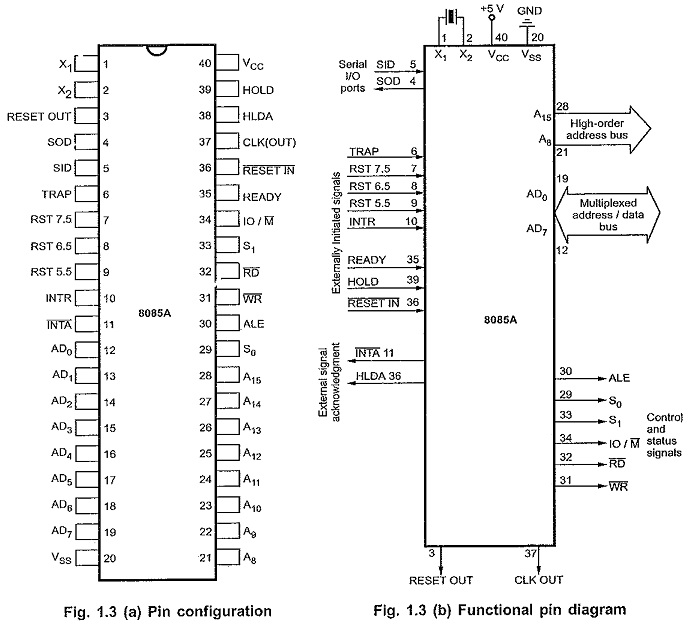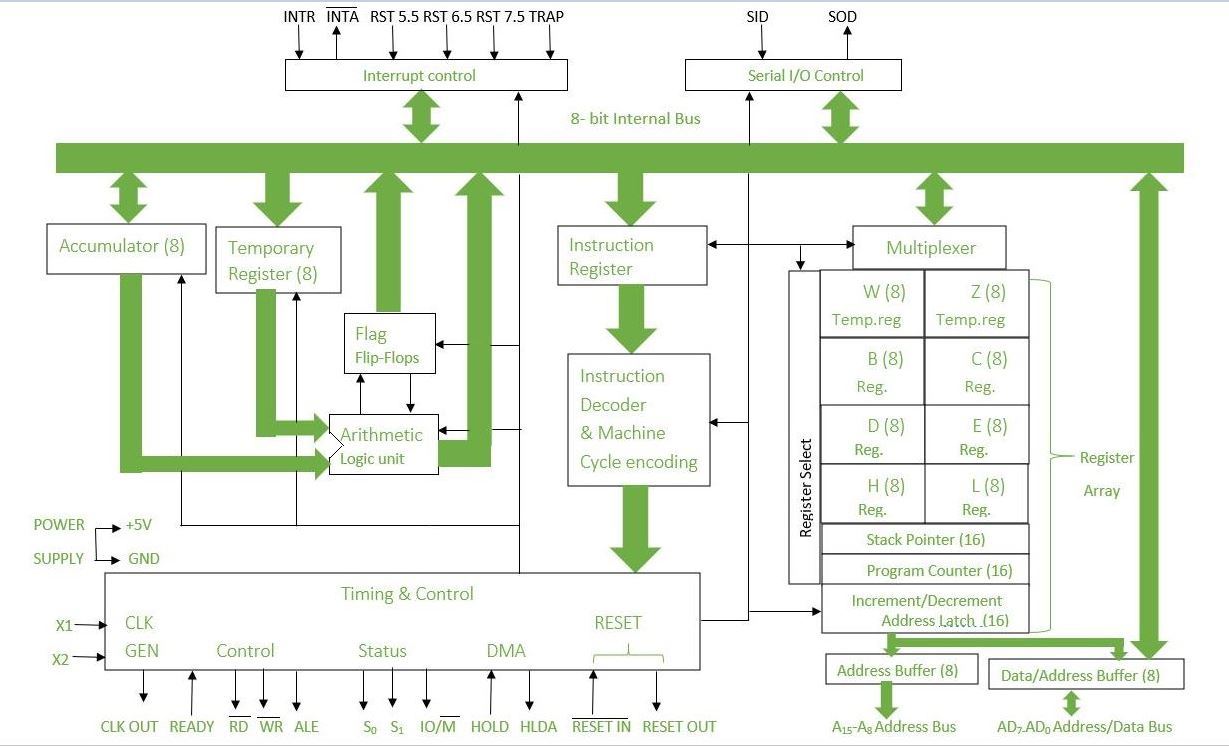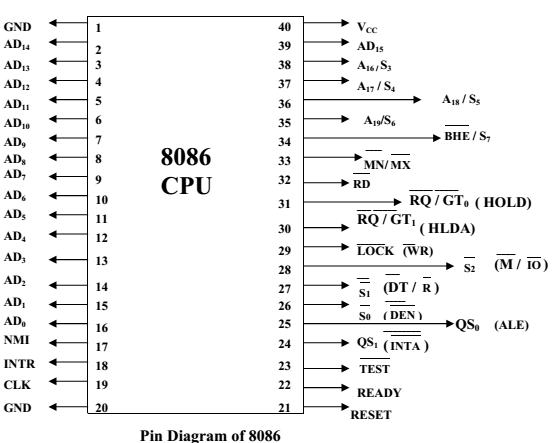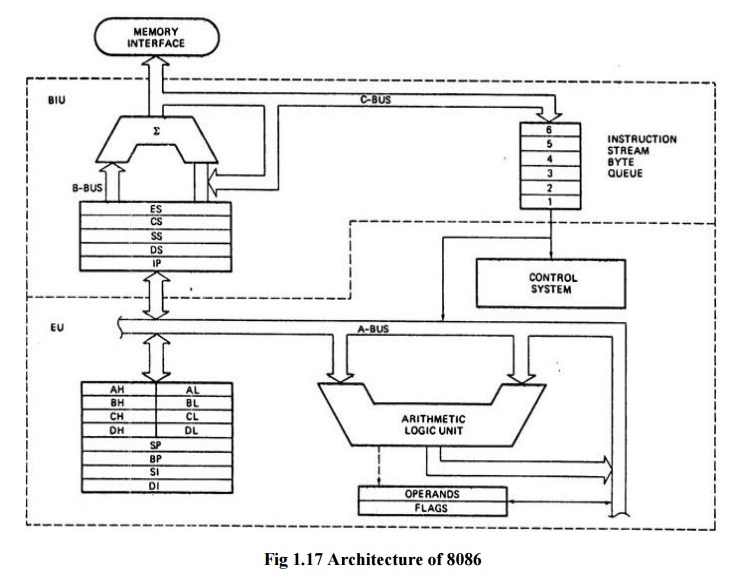What is a Microprocessor?
It is a CPU fabricated on a single chip, program-controlled device, which fetches the instructions from memory, decodes and executes the instructions.Define bit, byte and word.
Bit is either 0 or 1.Byte is group of 8 bits.
Word is group of 16 bits.
What is processor cycle (Machine cycle)?
The processor cycle or machine cycle is the basic operation performed by the processor. To execute an instruction, the processor will run one or more machine cycles in a particular order.
What is Instruction cycle?
The sequence of operations that a processor has to carry out while executing the instruction is called Instruction cycle. Each instruction cycle of a processor indium consists of a number of machine cycles.
What is fetch and execute cycle?
In general, the instruction cycle of an instruction can be divided into fetch and execute cycles. The fetch cycle is executed to fetch the opcode from memory. The execute cycle is executed to decode the instruction and to perform the work instructed by the instruction.



What are the important CPU registers in the 8085 microprocessor? Explain.
a. Accumulator (A): It is an 8-bit register which involves in all accumulator related instructions.b. Program counter (PC): It is a 16-bit register which carries the address of the next instruction to be executed.
c. General purpose registers (A, B, C, D, E, H, L): These registers can he used individually or as BC, DE and HL register pairs.
d. Stack pointer (SP): A 16-bit register always points the top of the stack.
e. Flag register (F): Contains five flags which indicate the processor status. Details of the flags are given below.
Carry flag: If a carry is generated in an arithmetic operation carry flag is set. The carry flag functions as a borrow flag for subtraction.
Auxiliary carry flag: Indicates the overflow from fourth bit of Accumulator due to arithmetic operation.
Sign flag: It indicates the sign of the number in the accumulator. MSB of accumulator indicates the sign of the number made of the remaining 7 bits. After the execution of arithmetic operation, if bit D7 of accumulator is 1, the sign flag will be set.
Parity flag: It sets to 1 if the parity of the accumulator content is even.
Zero flag: It sets to 1 if the result generated by certain instruction is zero.
Which are the addressing modes of 8085 ? Explain with examples.
a. Direct addressing: In this mode of addressing the address of the operand is specified in the instruction.Example: STA 4100; Address 4100 is specified in the instruction
b. Register addressing: Operands will be in the register.
Example: MOV A, B ; Name of the register will be specified in the instruction.
c. Register indirect addressing: Address of the operand will be placed in the register.
Example: MOV A, M ; address of the memory location is kept in HL pair.
d. Immediate addressing: Operand is specified in the instruction.
Example: MVI A, 44 ; datum 44 is specified in the instruction
What is Stack Pointer?
Stack pointer is a special purpose 16-bit register in the Microprocessor, which holds the address of the top of the stack.What is Program counter?
Program counter holds the address of either the first byte of the next instruction to be fetched for execution or the address of the next byte of a multi byte instruction, which has not been completely fetched. In both the cases it gets incremented automatically one by one as the instruction bytes get fetched. Also Program register keeps the address of the next instruction.How many data lines and address lines are in 8085 microprocessor?
8 data lines and 16 address lines.What is the use of HOLD pin of the microprocessor?
It supports the Direct Memory Access (DMA). When a interfacing device needs to access the microprocessor, DMA controller places a high input on HOLD line. Microprocessor then relinquishes the control of the bus and acknowledges the receipt of the request to the DMA controller. When the DMA operation is over, HOLD line will be brought down by the DMA controller and in turn, CPU exists from the hold state.What is clock frequency for 8085?
3 MHz is the maximum clock frequency for 8085.What is the use of ALE pin of 8085?
A positive going pulse on ALE line indicates that the bits on AD7 — AD0 are address bits. This signal is utilized to handle the low order address from the multiplexed bus and make a separate set of eight address lines.What is the use of READY pin of 8085?
Microprocessor waits until the signal on this line is high to access data from a peripheral device. This is used to delay the microprocessor Read or Write cycles until a slow peripheral device is ready to access the data.Give examples of one byte, two byte and three byte instructions.
One byte instruction: MOV B, CTwo byte instruction: MVI A, 33
Three byte instruction: LXI H, 4302H
Give an example each for data transfer, arithmetic, logical, branch and machine control instructions.
Data transfer: MOV A, BArithmetic: ADD A
Logical: ORA B
Branch: JMP 4127H
Machine control: HLT

What is an assembler and dissembler?
Assembler is a program that translates the mnemonics into corresponding machine codes. Dissembler does the opposite process.What are different parts for 8086 architecture?
The complete architecture of 8086 can be divided into 2types :-Bus Interface Unit(BIU) & Execution Unit. The BIU contains the circuit for physical address calculations and a precoding instruction byte queue & it makes the bus signals available for external interfacing of the devices. The EU contains the register set of 8086 except segment registers and IP.It has a 16-bit ALU,able to perform arithmetic and Logic operations.
What is an Interrupts
An interrupt operation suspends execution of a program so that the system can take special action.The interrupt routine executes and normally returns control to the interrupted procedure, which then resumes execution. BIOS handles Int 00H-1FH, whereas DOS handles INT 20H-3FH
What is an Opcode?
The part of the instruction that specifies the operation to be performed is called the Operation code or Op code.
What is an Operand?
The data on which the operation is to be performed is called as an Operand.
Explain the difference between a JMP and CALL instruction?
A JMP instruction permantely changes the program counter. A CALL instruction leaves information on the stack so that the original program execution sequence can be resumed.
Define Pipelining?
In 8086,to speedup the execution program,the instructions fetching and execution of instructions are overlapped each other. this is known as Pipelining.
What is the use of HLDA?
HLDA is the acknowledgment signal for HOLD. It indicates whether the HOLD signal is received or not. HOLD and HLDA are used as the control signals for DMA operations.
Difference between JMP and JNC?
JMP is Unconditional Branch. JNC is Conditional Branch.
What are the modes in which 8086 can operate?
The 8086 can operate in two modes and they are minimum (or uniprocessor) mode and maximum ( or multiprocessor) mode.
What is the data and address size in 8086?
The 8086 can operate on either 8-bit or 16-bit data. The 8086 uses 20 bit address to access memory and 16-bit address to access 1/0 devices.
What is Software interrupts?
The Software interrupts are program instructions. These instructions are inserted at desired locations in a program. While running a program, if software interrupt instruction is encountered then the processor executes an interrupt service routine.
What is Hardware interrupt?
If an interrupt is initiated in a processor by an appropriate signal at the interrupt pin, then the interrupt is called Hardware interrupt.
Where is the READY signal used?
READY is an input signal to the processor, used by the memory or I/O devices to get extra time for data transfer or to introduce wait states in the bus cycles.
What is HOLD and HLDA and how it is used?
Hold and hold acknowledge signals are used for the Direct Memory Access (DMA) type of data transfer. The DMA controller place a high on HOLD pin in order to take control of the system bus. The HOLD request is acknowledged by the 8085 by driving all its tristated pins to high impedance state and asserting HLDA signal high.





8051


Some of the features that have made the 8051 popular are:4 KB on chip program memory.
128 bytes on chip data memory(RAM)32 bytes devoted to register banks
16 bytes of bit-addressable memory
80 bytes of general-purpose memory
4 reg banks.
128 user defined software flags.
8-bit data bus
16-bit address bus
16 bit timers (usually 2, but may have more, or less).
3 internal and 2 external interrupts.
Bit as well as byte addressable RAM area of 16 bytes.
Four 8-bit ports, (short models have two 8-bit ports).
16-bit program counter and data pointer.
1 Microsecond instruction cycle with 12 MHz Crystal.
There are 4 8-bit ports: P0, P1, P2 and P3.
PORT P1 (Pins 1 to 8): The port P1 is a general purpose input/output port which can be used for a variety of interfacing tasks. The other ports P0, P2 and P3 have dual roles or additional functions associated with them based upon the context of their usage.The port 1 output buffers can sink/source four TTL inputs. When 1s are written to portn1 pins are pulled high by the internal pull-ups and can be used as inputs.PORT P3 (Pins 10 to 17): PORT P3 acts as a normal IO port, but Port P3 has additional functions such as, serial transmit and receive pins, 2 external interrupt pins, 2 external counter inputs, read and write pins for memory access.
PORT P2 (pins 21 to 28): PORT P2 can also be used as a general purpose 8 bit port when no external memory is present, but if external memory access is required then PORT P2 will act as an address bus in conjunction with PORT P0 to access external memory. PORT P2 acts as A8-A15
PORT P0 (pins 32 to 39) PORT P0 can be used as a general purpose 8 bit port when no external memory is present, but if external memory access is required then PORT P0 acts as a multiplexed address and data bus that can be used to access external memory in conjunction with PORT P2. P0 acts as AD0-AD7, as can be seen from fig 1.1
PORT P10: asynchronous communication input or Serial synchronous communication output.



Post a Comment
0 Comments